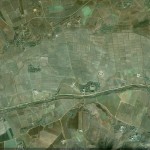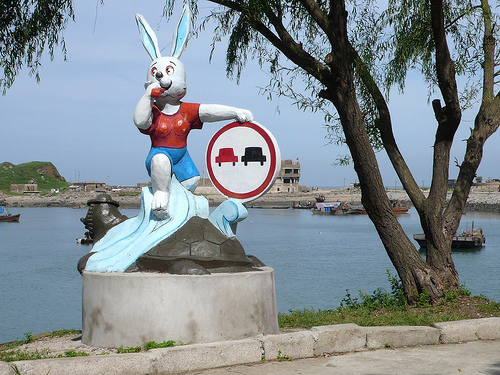The Daily NK has run a series of interesting articles on education in the DPRK. I have posted interesting excerpts below:
The Warped Nature of Gifted Student Schooling
Daily NK
By Moon Sung Hwee,
7/17/2009
The birth of education for the gifted generated a new social trend which placed great value on science. First senior middle schools grew out of that trend.
In first senior middle schools, students are educated in the natural sciences using high quality text books produced especially for the task.
Only the graduates of these schools can enter elite science universities such as Pyongsung-ri College of Science, Kangkye College of Defense or the elite KimChaek University of Technology. Since 1992, the first generation of graduates has been distinguishing itself in professional fields. Naturally, they have had a great affect on military and scientific technological developments.
Being a first middle school student is even an exemption from compulsory military service.
In addition to being a shelter from undesirable military obligations, as graduates from the school tend to work in better positions in society, the first senior middle school is a great path to a comfortable future.
However, powerful and wealthy parents lobby hard to get their children into a first middle school, and as a consequence what was supposed to be national education for gifted students has degenerated into a school for the children of the rich and politically powerful classes. To add insult to injury, as the numbers of elite first middle school graduates rises, the number of opportunities for other, general students falls even further.
And indeed, since the March of Tribulation in the mid-1990s, this discrimination has grown more and more serious, so now there is practically zero opportunity for average children to enter the first middle school at all, and therefore little chance to use their innate abilities to climb the social ladder.
This is because, during and after the March of Tribulation, ideological training, “[proletarian] class spirit education,” seriously distorted the system of gifted-student education.
Through this “(proletarian) class spirit education,” under the slogan, “Without the revolutionary and proletarian classes we cannot maintain the achievements of the revolution,” the authorities emphasized the need for the Juche Ideology to dominate society. The classes encouraged abhorrence of capitalists and the bourgeoisie via lessons about capitalist contradictions and the superiority of socialist system.
Since 1998, revolutionary education facilities for (proletarian) class spirit education have been built in every province, city, county and neighborhood. This has changed society markedly, because since the Kim Il Sung period, until the March of Tribulation, the only area of life where class or family background had not had an effect on an individual’s chances was education.
This has resulted in the concept of three classes and 51 groups in society, formed originally in the 1970s, being more rigorously applied: the core class (workers, former farm hands, party members, intellectuals educated after 1945, etc.); the unsettled class (traders, intellectuals educated before 1945, former Confucian scholars and etc.); and the hostile class (former rich farmers, former landlords, pro-Japanese factions, religious persons, criminals’ families, those who have been exiled etc.). The unfavorable classes and groups have since grown more sharply defined and discriminated against, with different classes receiving vastly different treatment.
This has cemented a hereditary social system, and the vicious cycle of family background and class being passed down to descendants has irrevocably formed. Of course, the standard for admission to a school is also class. Ability is no longer of any relevance whatsoever. Now, countless young minds just wither on the vine.
General students feel defeatist when evaluating themselves, thinking they are losers with no social footholds. Since they are not elite students, and are not of a favorable class background, their chances are vanishingly small.
So, what do such groups do? Well, parents in lower classes who would have used education to help their kids escape from poverty or an unstable class have developed an interest in other methods, beyond the school gates. Money.
Since they cannot change their family background, these parents and students have started to believe that they need to earn a great deal of money to be able to give their children a chance. Not a side effect the authorities had hoped for.
Private Education Is Most Effective for Every Class
Daily NK
By Moon Sung Hwee
7/24/2009
Since the devastation wrought by the March of Tribulation in the late 1990s, education in North Korea has been firmly on the back burner.
When state food distribution ceased, teachers either could not go to school or simply handed in their resignations, while starving children simply stopped attending school. Therefore, even the basic operation of schools was extremely difficult.
One Seoul-based defector, who used to be in charge of military recruitment, explained the situation vividly, “More than half the candidates for military service came to take their physical examination wearing no underwear during the March.”
A Starving Student Rarely Attends School
Children whose parents had starved to death started appearing in large numbers, wandering the streets. People called them “kotjebi.”
Among those parents lucky enough not to starve, very few in the poorer classes bothered educating their children at all, saying, “Since you can’t move up due to your social status, you don’t need to go school. The only things you need are the reading and arithmetic that are needed in the jangmadang.” This has generated a vicious circle of poverty which continues to this day.
Meanwhile, most children in the middle social classes did not go to school either, but to the markets to do what business they could.
Declining attendances in schools wreaked havoc, of course. Since 2000 the North Korean authorities have been trying to bring schools back to life by harshly punishing parents whose children do not come to school.
Nevertheless, even elite children with politically and financially sound family backgrounds have given up on school. However, their reason is different; their parents are dissatisfied with the poor standard of education in public schools, so they have shifted into the private education field.
In reality, schools are equipped with ageing facilities, suffer a severe lack of materials and receive little state investment, so effective education is all but impossible.
For example, since 1985 there has been a chapter on computers in mathematics text books, and computer education has been nominally on the curriculum. However, IT education is purely theoretical, because there are no computers in any but the First Middle Schools.
A Starving Teacher is not a Good Teacher
A teacher who is not able to live on his or her wages alone will always have difficulties paying attention to teaching students, and either the teacher, or the students, or both, will seek alternative ways to achieve their goals.
From the late 1980s, informal private education started to appear in North Korea for the first time, in the form of music lessons. At the time, those who used to work for art units started teaching the accordion or violin to senior school students.
However, a decisive turning point in bringing about a boom in private education was the appearance of DVD players. Since around 2005, DVD players have become almost a necessity for senior school students.
Households use legal educational DVDs produced by Education and Culture Broadcasting, which is publicly aired only in Pyongyang, and illegally copied ones which feature recorded lectures by First Senior Middle School teachers. It is more effective than public school education, because they can see well-edited lectures by good teachers, rather than attending half-hearted ones by the disillusioned teachers in the general school system.
This home-schooling method has spread widely, even extending to elementary students.
In March this year, during the enrollment period for elementary school, an unprecedented “freshmen enrollment notice” containing a list of children required to start school was stuck up in public areas. This was due to rapidly declining freshman enrollment.
North Korea Intellectuals Solidarity (NKIS) released the story on March 17, quoting a North Korean source as saying, “Such a notice is the first in North Korean history.” Additionally, the source reported, “Affluent people can educate their children privately with the money which they would have to provide to public school every month plus a bit more. Therefore, they will not send their children to school. Private math or physics tutors can earn up to 30,000 North Korean won per month, and music or art tutors as much as 50,000 won.”
Student Labor Utliized in Every Field
Daily NK
By Moon Sung Hwee
7/28/2009
As the Kim Jong Il period started in the 1980s, students became subject to many more kinds of unwelcome social mobilization.
For example, students were made to carry water from local rivers in order to build a skating rink every winter, and to take part in the construction of railroads, swimming pools and many other construction projects in their neighborhoods almost daily.
Farm support activities, the domain of third grade middle school students, have long been a conventional method of exploiting North Korean child labor. Every spring the kids have to build seedbeds of corn, transplant rice for more than ten days in summer and then help bring in the harvest for a full month in fall.
They are made to harvest crops until late in the evening, while five or six students are put up in each farmer’s house for the duration. In summer, schools give the students ten days vacation, in which they are ordered to collect fresh bracken and other wild plants.
The authorities in cities and towns periodically mobilize students and factory workers to repair railroads or roads as well. Sunday, the only official day-off in North Korea, is now a day for mobilizing students instead.
Since social mobilization comes frequently, students are often far from their studies, so teachers simply devote themselves to the maintenance of schools.
Since the March of Tribulation in the late 1990s, the atmosphere in the education sector has changed a lot. Since that time, the authorities have found it difficult to push students into social mobilization, since they can’t even afford lunch, or to manage schools, because the number of those who are willing to give up their chance of an education has drastically increased.
A source from Hoiryeong, North Pyongan Province reported recently that the percentage of students who go to school is now 62 percent, according to a recent report from the education department of Hoiryeong’s municipal Party Committee.
Absence from school is more serious on Saturday than on any other day because there are weekly evaluation meetings on the students’ daily lives, and several other onerous and to-be-avoided tasks like the offering of rabbit furs or metal scraps.
Meanwhile, the North Korean authorities have been focusing on inspiring student loyalty to the ongoing 150-Day Battle, but the result has been quite the opposite.
In 1980, the first work on the daily student routine was a “Sincerity Task;” cleaning up the surroundings of the local Kim Il Sung statue, portraits and the like. Students naturally addressed the task with care and diligence.
However, the number of students seen even doing such things has decreased markedly since the early 1990s, let alone doing it well. Moreover, students who are prepared to undertake such tasks are branded “brown noses.”
One recent example can be found in Hyesan: in advance of the anniversary of Kim Il Sung’s death on July 8, the authorities mobilized local students to clean up the Bocheonbo Battle Monument. Yet, on one of the allocated days only a few students turned up, while on other days there was no one there at all, according to our source.



